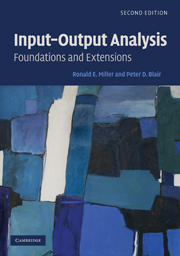Book contents
- Frontmatter
- Contents
- List of Figures
- List of Tables
- Preface
- 1 Introduction and Overview
- 2 Foundations of Input–Output Analysis
- 3 Input–Output Models at the Regional Level
- 4 Organization of Basic Data for Input–Output Models
- 5 The Commodity-by-Industry Approach in Input–Output Models
- 6 Multipliers in the Input–Output Model
- 7 Nonsurvey and Partial-Survey Methods: Fundamentals
- 8 Nonsurvey and Partial-Survey Methods: Extensions
- 9 Energy Input–Output Analysis
- 10 Environmental Input–Output Analysis
- 11 Social Accounting Matrices
- 12 Supply-Side Models, Linkages, and Important Coefficients
- 13 Structural Decomposition, Mixed and Dynamic Models
- 14 Additional Topics
- Appendix A Matrix Algebra for Input–Output Models
- Appendix B Reference Input–Output Tables for the United States (1919–2006)
- Appendix C Historical Notes on the Development of Leontief's Input–Output Analysis
- Author Index
- Subject Index
5 - The Commodity-by-Industry Approach in Input–Output Models
Published online by Cambridge University Press: 05 June 2012
- Frontmatter
- Contents
- List of Figures
- List of Tables
- Preface
- 1 Introduction and Overview
- 2 Foundations of Input–Output Analysis
- 3 Input–Output Models at the Regional Level
- 4 Organization of Basic Data for Input–Output Models
- 5 The Commodity-by-Industry Approach in Input–Output Models
- 6 Multipliers in the Input–Output Model
- 7 Nonsurvey and Partial-Survey Methods: Fundamentals
- 8 Nonsurvey and Partial-Survey Methods: Extensions
- 9 Energy Input–Output Analysis
- 10 Environmental Input–Output Analysis
- 11 Social Accounting Matrices
- 12 Supply-Side Models, Linkages, and Important Coefficients
- 13 Structural Decomposition, Mixed and Dynamic Models
- 14 Additional Topics
- Appendix A Matrix Algebra for Input–Output Models
- Appendix B Reference Input–Output Tables for the United States (1919–2006)
- Appendix C Historical Notes on the Development of Leontief's Input–Output Analysis
- Author Index
- Subject Index
Summary
Introduction
In this chapter we explore a variation in the underlying data sets from which an input– output model is constructed. Using a “commodity–industry” format, we are able to account for the fact that an industry may produce more than one commodity (product). This was a major reason for the introduction of the commodity–industry accounting system – to explicitly account for “non-characteristic” production such as secondary products and by-products. In addition, data organized in this way are more easily integrated with a broader system of national accounts (SNA) for a country, as we saw in Chapter 4. These commodity–industry accounts lead to input–output models that have more complicated structures than those in Chapters 2 and 3; commodity–industry models are the concern of this chapter. The large Eurostat manual (Eurostat/European Commission, 2008) provides an excellent and comprehensive discussion of this framework. There, as in many other publications, “product” is used instead of “commodity.” We will use “commodity” in this text because that is the predominant terminology associated with the early derivations and discussions of this system, in the 1960s and 1970s, and it continues to be used by many analysts.
The commodity-by-industry accounting framework originated largely in the work of Sir Richard Stone and his associates (Stone, 1961; Cambridge University, 1963). It was proposed in 1968 by the United Nations as a standard for data gathering in countries throughout the world (United Nations, 1968), and it subsequently has become a feature of data collection and input–output statistics virtually everywhere. (United Nations et al., 1993.
- Type
- Chapter
- Information
- Input-Output AnalysisFoundations and Extensions, pp. 184 - 242Publisher: Cambridge University PressPrint publication year: 2009

